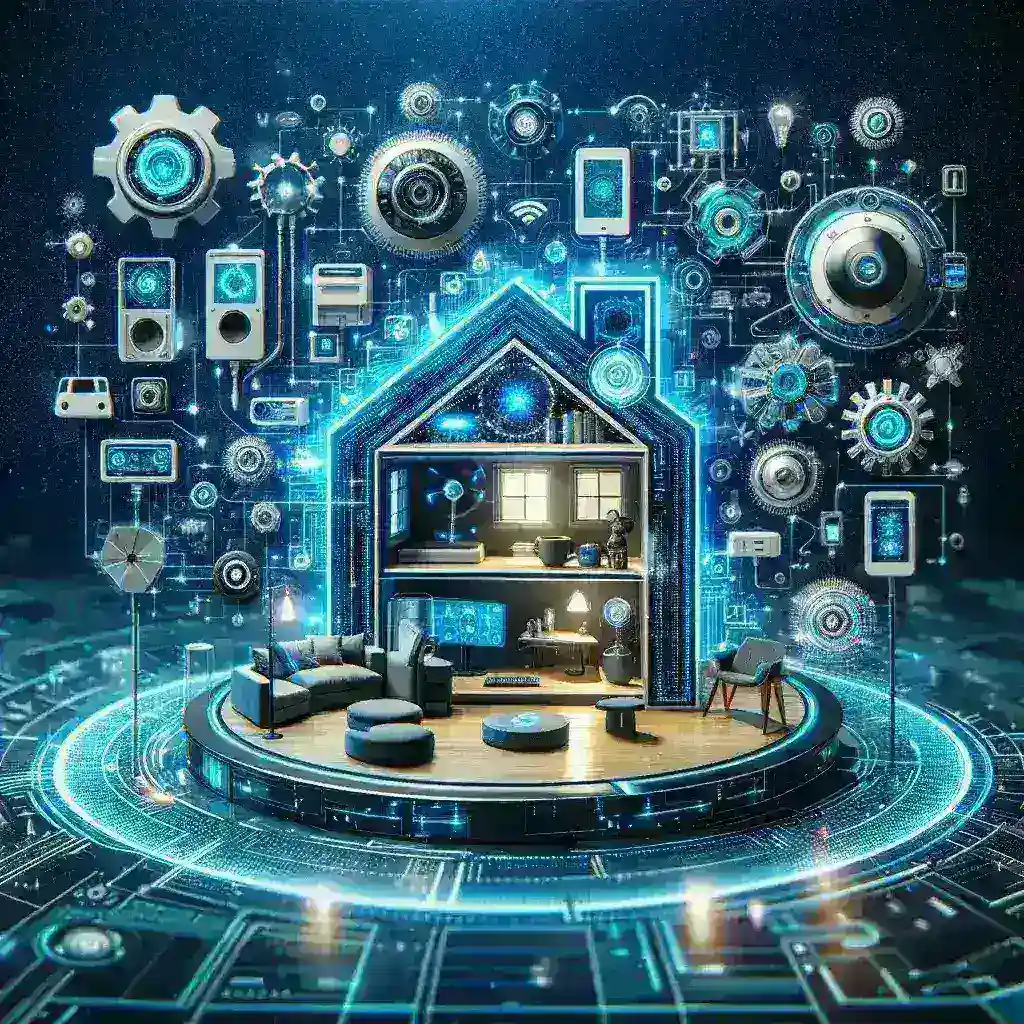Introduction to AI-Powered Smart Home Systems
The concept of a smart home has evolved dramatically over the past decade. What once began as simple programmable devices has transformed into sophisticated ecosystems where artificial intelligence orchestrates seamless interactions between multiple devices. Today’s smart home systems integrate AI for seamless device control, creating living spaces that not only respond to commands but anticipate needs, learn preferences, and adapt to changing circumstances. This technological revolution is changing how we interact with our homes and redefining our expectations of comfort, convenience, and efficiency.
The integration of AI into smart home systems represents one of the most significant advancements in residential technology. These intelligent systems now coordinate everything from lighting and temperature to security and entertainment, creating cohesive environments that respond intuitively to their occupants. As we delve deeper into this technological marvel, we’ll explore how AI is fundamentally transforming the smart home landscape and why this integration matters for homeowners, technology enthusiasts, and the future of residential living.
The Evolution of Smart Home Technology
To understand the significance of AI integration in smart homes, we must first appreciate the journey that brought us here. The evolution of smart home technology spans several distinct phases, each building upon the innovations of the previous.
From Basic Automation to Connected Devices
The earliest iterations of smart home technology focused on simple automation. Programmable thermostats and timer-based lighting systems offered basic convenience but lacked true intelligence. These systems operated on predetermined schedules and required manual adjustments to accommodate changes in routine or preference.
The next significant leap came with the introduction of connected devices. The emergence of the Internet of Things (IoT) enabled devices to communicate with one another and with central control systems. Suddenly, homeowners could remotely adjust their thermostats, turn lights on or off, and monitor security cameras from their smartphones. This connectivity represented a major advancement but still relied heavily on human intervention for most operations.
The Rise of Voice Assistants and Control Hubs
The introduction of voice assistants like Amazon’s Alexa, Google Assistant, and Apple’s Siri marked another pivotal moment in smart home evolution. These platforms provided natural language interfaces that simplified device control and made smart home technology more accessible to mainstream consumers. Control hubs emerged as central nodes that could manage diverse ecosystems of devices from different manufacturers, addressing fragmentation issues that had previously limited adoption.
While these innovations significantly improved the smart home experience, they still primarily executed explicit commands rather than demonstrating true intelligence. The systems could respond to requests but couldn’t anticipate needs or adapt to changing circumstances without direct instruction.
The AI Revolution in Smart Homes
The integration of advanced artificial intelligence represents the current frontier of smart home technology. Modern AI-powered systems go beyond simple command execution to incorporate learning, prediction, and adaptation. These systems analyze patterns of behavior, environmental conditions, and user preferences to make informed decisions without constant direction.
This evolution from programmable to truly intelligent systems marks a fundamental shift in how we interact with our homes. Rather than merely controlling devices, we now collaborate with intelligent systems that share the goal of creating comfortable, efficient, and secure living environments.
Core AI Technologies Powering Modern Smart Homes
Behind the seamless operation of today’s intelligent smart homes lies a sophisticated array of AI technologies. Understanding these foundational elements helps appreciate how modern systems achieve their remarkable capabilities.
Machine Learning: The Foundation of Smart Home Intelligence
Machine learning forms the backbone of AI-powered smart home systems. These algorithms analyze data from various sources—including device usage patterns, environmental sensors, and explicit user preferences—to identify patterns and make predictions. Over time, machine learning models become increasingly accurate, fine-tuning their operations to align with household routines and preferences.
For example, a smart thermostat using machine learning doesn’t just follow a preset schedule. It learns when occupants typically arrive home, how quickly the house heats or cools under various weather conditions, and individual temperature preferences for different rooms and times of day. This learning enables the system to maintain optimal comfort while maximizing energy efficiency.
Natural Language Processing for Intuitive Interaction
Natural Language Processing (NLP) has dramatically transformed how we interact with smart home systems. Advanced NLP allows systems to understand not just simple commands but complex, conversational requests with contextual awareness. Modern voice assistants can interpret nuanced instructions like “make it a bit warmer in the living room, but not too much” or “set up the house for movie night”—translating these natural expressions into specific actions across multiple devices.
The sophistication of NLP continues to advance, with systems now capable of understanding different accents, filtering out background noise, and even detecting emotional cues in voice patterns to provide more appropriate responses.
Computer Vision for Enhanced Awareness and Security
Computer vision technology enables smart home systems to “see” and interpret their surroundings. Smart cameras equipped with computer vision can distinguish between family members, pets, and strangers; detect unusual activities; and even identify specific objects or situations that might require attention.
Beyond security applications, computer vision enhances everyday functionality. Smart refrigerators can inventory their contents, smart mirrors can provide fashion advice, and vision-enabled systems can adjust lighting based on activities occurring in a room. This visual intelligence adds another dimension to how smart homes understand and respond to their occupants.
Predictive Analytics for Anticipatory Control
Perhaps the most impressive aspect of AI-powered smart homes is their ability to anticipate needs through predictive analytics. By analyzing historical data and identifying patterns, these systems can predict future requirements and take proactive measures.
A sophisticated smart home might notice that you typically arrive home from work between 5:30 and 6:00 PM on weekdays. Rather than waiting for a command, it can prepare the house by adjusting the temperature, turning on specific lights, and perhaps even starting to preheat the oven if cooking patterns suggest you’ll be preparing dinner. These predictive capabilities transform the smart home from reactive to proactive, often addressing needs before the occupant even thinks to issue a command.
Seamless Device Control: How AI Orchestrates the Smart Home Symphony
The true magic of AI in smart homes lies in its ability to orchestrate seamless coordination across diverse devices and systems. This orchestration creates experiences that transcend the capabilities of individual smart devices operating in isolation.
Unified Control Through AI Orchestration
Modern smart homes often contain dozens of connected devices from multiple manufacturers, each with its own capabilities and communication protocols. AI serves as the conductor of this technological orchestra, creating harmony from potential chaos. Sophisticated AI systems can manage these diverse elements as a cohesive whole, translating high-level objectives into coordinated actions across multiple devices.
When a homeowner says “I’m going to bed,” an AI-powered system understands this as a trigger for a sequence of actions: adjusting the thermostat to optimal sleeping temperatures, locking doors and activating security systems, turning off lights in unoccupied rooms while perhaps dimming hallways for nighttime navigation, and setting devices like smartphones to do-not-disturb mode.
Contextual Awareness for Intelligent Decision Making
AI brings contextual awareness to smart home systems, enabling them to make nuanced decisions based on current circumstances rather than rigid rules. This awareness considers factors like time of day, weather conditions, occupancy patterns, and even the specific activities taking place within the home.
For instance, when adjusting lighting, an AI system might consider natural light levels from windows, the specific activity being performed (reading requires different lighting than watching TV), the occupant’s historical preferences, and even energy efficiency goals. This multifaceted decision-making creates environments that feel naturally responsive rather than mechanically programmed.
Adaptive Routines That Evolve Over Time
Perhaps the most sophisticated aspect of AI-powered device control is the ability to create adaptive routines that evolve over time. Rather than following static programs, these systems continuously refine their operations based on feedback, both explicit (when users override settings) and implicit (observing patterns of interaction).
A truly intelligent system might notice that despite programming the thermostat for energy efficiency during work hours, a household member frequently adjusts the temperature on Wednesdays. The system might identify that this person works from home on Wednesdays and automatically adjust its schedule to accommodate this pattern, eliminating the need for manual intervention.
Real-World Applications of AI in Smart Home Systems
The integration of AI into smart home systems manifests in numerous practical applications that enhance comfort, convenience, security, and efficiency. Let’s explore some of the most impactful implementations currently transforming residential spaces.
Intelligent Climate Control
Climate control represents one of the most sophisticated applications of AI in smart homes. Modern systems go far beyond simple programmable thermostats to create truly intelligent environmental management:
- Multi-zone optimization that balances temperature preferences across different rooms based on occupancy and usage patterns
- Weather-adaptive adjustments that anticipate and respond to changing external conditions before they impact indoor comfort
- Occupancy prediction that prepares spaces for arrival and conserves energy during absences
- Learning-based efficiency that continuously refines operation to minimize energy consumption while maximizing comfort
These systems integrate data from multiple sources—including room sensors, weather forecasts, smart calendars, and historical usage patterns—to create climate management that feels intuitive and personalized.
Adaptive Lighting Ecosystems
AI-powered lighting systems transform the ambiance of homes through intelligent control of intensity, color, and timing:
- Activity-based lighting scenes that automatically adjust to complement different activities like cooking, entertaining, or relaxing
- Circadian rhythm support that mimics natural daylight patterns to promote well-being and healthy sleep cycles
- Presence-aware illumination that lights paths through the home based on movement and anticipated destinations
- Mood-responsive adjustments that can detect atmosphere through music choices, voice patterns, or explicit requests
These lighting ecosystems create environments that feel naturally responsive rather than artificially automated, enhancing both the functionality and emotional experience of home spaces.
Comprehensive Security Integration
Security represents a domain where AI integration delivers particularly significant benefits through intelligent monitoring and response:
- Anomaly detection that identifies unusual patterns or behaviors that deviate from household norms
- Smart access control that adapts security protocols based on recognized individuals, time of day, and expected visitors
- Integrated threat response that coordinates multiple systems (lights, alarms, notifications) when potential security issues are detected
- False alarm reduction through intelligent analysis that distinguishes between genuine threats and benign occurrences
AI-powered security systems provide peace of mind through constant vigilance that feels protective rather than intrusive, striking the delicate balance between security and privacy.
Energy Management and Optimization
Smart homes increasingly serve as hubs for sophisticated energy management, using AI to balance comfort with conservation:
- Dynamic consumption analysis that identifies energy usage patterns and suggests optimization opportunities
- Renewable integration that maximizes the use of solar or other renewable sources when available
- Load balancing that distributes energy usage to avoid peaks and potentially reduce utility costs
- Predictive maintenance alerts that identify potential issues in HVAC and other systems before they lead to inefficiency or failure
These systems deliver both environmental and financial benefits, often achieving significant energy savings without requiring occupants to sacrifice comfort or convenience.
The User Experience: Interacting with AI-Powered Smart Homes
The integration of AI has fundamentally transformed how residents interact with their smart homes, creating experiences that feel more natural, intuitive, and personalized than ever before.
From Command-Driven to Conversation-Based Interaction
Early smart home interfaces relied primarily on explicit commands—specific instructions that triggered predefined actions. While effective, this approach required users to learn system-specific language and remember particular phrases or sequences.
AI-powered systems have shifted toward conversational interaction models that accommodate natural language, context awareness, and even non-verbal cues. Residents can now express needs in casual, human terms (“I’m feeling chilly” rather than “Increase temperature by two degrees”), and the system interprets these expressions appropriately.
Advanced systems incorporate continuous conversation capabilities, maintaining context across multiple exchanges and building understanding over time. This progression toward more natural communication significantly reduces the cognitive burden of managing a smart home and makes the technology accessible to users regardless of technical proficiency.
Personalization and Multi-User Accommodation
Modern AI-powered smart homes excel at personalization—recognizing different household members and adapting to their specific preferences and habits. Voice recognition, smartphone presence, and even gait analysis through floor sensors allow systems to identify who is present and tailor the environment accordingly.
This personalization extends beyond basic preferences to encompass complex accommodations for different user needs. For example, a system might automatically adjust lighting brightness and color temperature for an elderly resident who requires higher illumination levels, while simultaneously managing entertainment options for children in another room and maintaining optimal workspace conditions for someone working from home.
The ability to seamlessly switch between different user profiles without explicit instruction creates homes that feel individually attentive to each occupant while maintaining harmony across shared spaces.
Transparent Operation and User Control
Despite their increasing sophistication, effective AI-powered smart homes maintain transparency in their operations and preserve user control. The best systems clearly communicate what they’re doing and why, providing visibility into automated decisions while allowing for easy overrides when desired.
This balance between automation and control represents a crucial aspect of user experience design. Systems that make unexplained changes or resist user intervention quickly become frustrating, while those that require constant confirmation undermine the convenience that smart homes promise.
Modern interfaces achieve this balance through techniques like ambient notifications (subtle lighting changes that indicate system status), progressive disclosure (providing basic information with options to see more detail), and multi-layered control (offering both simple overrides and deeper configuration options).
Overcoming Challenges in AI-Powered Smart Home Systems
While the integration of AI into smart home systems offers tremendous benefits, it also presents significant challenges that manufacturers, developers, and users must navigate. Understanding these challenges is essential for creating systems that deliver on the promise of seamless, intelligent home automation.
Privacy and Data Security Considerations
AI-powered smart homes necessarily collect substantial data about household activities, preferences, and patterns. This data collection raises important privacy considerations that must be thoughtfully addressed:
- Data minimization principles that limit collection to information genuinely needed for system functionality
- Local processing options that keep sensitive data within the home rather than transmitting it to cloud servers
- Transparent data policies that clearly communicate what information is collected and how it’s used
- Robust security measures that protect against unauthorized access to smart home systems and data
The most trusted smart home platforms now incorporate privacy-by-design principles, giving users granular control over data collection and emphasizing security at every level of system architecture.
Interoperability and Ecosystem Integration
The fragmentation of the smart home market creates significant challenges for seamless device control. Different manufacturers often use proprietary protocols and platforms, creating potential compatibility issues:
- Cross-platform standards like Matter and Thread that aim to create universal compatibility across devices
- Translation layers that allow AI systems to communicate with devices using various protocols
- API ecosystems that enable developers to create integrations between previously incompatible systems
- Unified control interfaces that present a consistent user experience regardless of the underlying device diversity
Progress in this area continues to accelerate as major technology companies recognize that interoperability benefits the entire smart home industry by improving user experiences and expanding the market.
Reliability and Fallback Mechanisms
As homes become increasingly dependent on AI-powered systems for essential functions, reliability becomes paramount. Smart home architectures must incorporate robust fallback mechanisms:
- Graceful degradation that maintains core functionality even when parts of the system are compromised
- Local control options that continue to work during internet outages or cloud service disruptions
- Redundant systems for critical functions like security and environmental control
- Predictive maintenance that identifies potential failures before they impact system performance
The most sophisticated smart home systems now incorporate multiple layers of reliability protection, ensuring that residents never find themselves unable to control essential home functions.
Accessibility and Inclusive Design
Smart home technology holds particular promise for enhancing independence for elderly individuals and those with disabilities, but this potential can only be realized through thoughtful inclusive design:
- Multi-modal interfaces that accommodate different abilities and preferences for interaction
- Adaptive controls that adjust to user capabilities and needs
- Configurable feedback mechanisms that provide appropriate confirmation of system actions
- Simplified operation modes that reduce cognitive load for users who may find complex systems challenging
Leading manufacturers increasingly incorporate accessibility considerations from the earliest stages of product development, recognizing that inclusive design ultimately creates better products for all users.
The Future of AI in Smart Home Systems
As impressive as today’s AI-powered smart homes are, they represent just the beginning of a technological revolution that continues to accelerate. Looking ahead, several emerging trends promise to further transform how we interact with our living spaces.
Advanced Predictive Intelligence
The next generation of smart home AI will feature dramatically enhanced predictive capabilities that anticipate needs with uncanny accuracy. These systems will utilize more sophisticated models that incorporate a broader range of contextual factors:
- Emotional intelligence that recognizes and responds to occupants’ moods and emotional states
- Health-aware environments that adjust conditions to support wellbeing based on biometric data and health patterns
- Anticipatory preparation that readies the home for specific activities before they’re explicitly requested
- Life pattern adaptation that recognizes and accommodates major life changes like new work schedules or family additions
These advances will create homes that feel almost intuitively connected to their residents’ needs, often preparing for requirements before the occupants themselves are consciously aware of them.
Ambient Intelligence and Invisible Interfaces
The future of smart home interaction lies in ambient intelligence—systems that blend seamlessly into the background while remaining constantly attentive and responsive. This evolution will increasingly eliminate the need for explicit interfaces:
- Spatial computing that uses augmented reality to overlay controls and information directly onto the physical environment
- Gesture recognition that interprets natural movements as control inputs without requiring specific devices
- Ubiquitous sensing through distributed, unobtrusive sensors integrated into building materials and furnishings
- Context-aware responses that consider location, activity, time, and social situation when determining appropriate actions
This shift toward ambient intelligence represents perhaps the ultimate expression of seamless device control—technology that serves its purpose without demanding attention or explicit interaction.
Integration with Robotics and Physical Automation
While current smart homes primarily control fixed systems like lighting and climate, the integration of robotics will expand automation into the physical realm:
- Adaptive furniture that reconfigures based on activities and needs
- Household robots that perform physical tasks coordinated by the central AI system
- Automated maintenance systems that clean, monitor, and repair home infrastructure
- Modular environments that physically transform to accommodate different functions throughout the day
This convergence of digital intelligence with physical capability will enable smart homes to not just control the environment but actively reshape it to better serve their occupants.
Sustainability and Resource Optimization
Future AI systems will place increasing emphasis on sustainability, optimizing resource usage with unprecedented precision:
- Closed-loop resource management for water, energy, and consumables
- Predictive energy harvesting that maximizes renewable generation and storage
- Waste reduction systems that minimize environmental impact through smart consumption
- Community-level optimization that coordinates resources across multiple homes for greater efficiency
These systems will help reconcile the desire for comfort and convenience with environmental responsibility, using intelligent optimization to reduce resource consumption without sacrificing quality of life.
Conclusion: The Seamless Integration of AI and Daily Living
The integration of AI into smart home systems for seamless device control represents more than a technological advancement—it signifies a fundamental shift in the relationship between people and their living spaces. As these systems become more sophisticated, intuitive, and pervasive, they increasingly blur the line between technology and environment, creating homes that feel naturally responsive rather than mechanically automated.
The journey from basic automation to true intelligence has transformed smart homes from novelties into essential infrastructure that enhances comfort, convenience, security, and efficiency. AI serves as the crucial bridge between disparate devices and systems, orchestrating their operation into a cohesive whole that’s greater than the sum of its parts.
Looking ahead, the continued evolution of AI-powered smart homes promises even more seamless integration into daily life. As interfaces become more natural, prediction more accurate, and operation more reliable, these systems will increasingly fade into the background of consciousness while playing an ever more important role in creating living environments optimized for human wellbeing.
The ultimate promise of AI in smart homes isn’t about technology for its own sake, but about creating spaces that understand and support their occupants in fundamentally human ways—anticipating needs, adapting to preferences, and removing friction from daily life. In this vision of the future, the most sophisticated technology becomes the least noticeable, quietly enhancing life without demanding attention or effort.
As we continue this technological journey, the focus must remain on the human experience at the center of these innovations. The most successful smart home implementations will be those that not only demonstrate technical sophistication but truly understand and serve the complex, nuanced needs of the people who inhabit these spaces. In that harmony between advanced technology and human-centered design lies the true potential of AI-powered smart homes.



